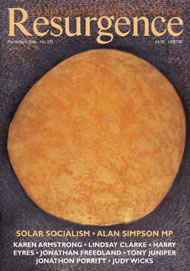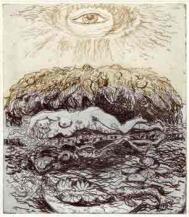From the moment you open this book’s shimmering cover you know that you’re holding something special; and the ambiguous nature of that binding’s colour, altering according to the light in which you hold it, prefigures the alchemical vision which gives these poems their particular radiance. The title too, bringing together the pagan god who became the tutelary spirit of the alchemical art with a powerful female icon of the Christian gospels, indicates that what you are about to read will have a heretical edge to it. In fact, as John Moat suggests, there is a sense in which this volume of poems can be seen as a Gnostic testament for our times. With its finely worked etchings performing a harmonious descant to the text, it might also be viewed as a refreshingly contemporary updating of the 17th-century tradition of the Emblem Book.
Moat’s new collection takes him deeper into an already deep preoccupation with the difficult dialogue between the masculine and feminine principles through which the problem of the reconciliation of the opposites is most plainly dramatised in our personal experience. But such language is too abstract to convey the sharply realised actuality of these poems. Moat’s eyes have always been alert to the everyday marvels of the natural world, and his ear has long been attuned both to the rhythms by which such marvels can be conjured in verse and to what is liveliest in idiomatic speech. Add to that his diligent care for the craft of verse and you have a rare sensibility, peculiarly well-equipped to undertake the task of finding language for what is most fugitive in our experience.
Moat writes for and from a world in which “We are too far gone to see sense” and “Words disavow all we know.” And the only way to enter that world is to follow the bidding of his imagination by reading the poems and contemplating the images that accompany them. That journey will take you through fourteen poems under the aegis of Hermes, fourteen more over which the Goddess presides, and a final section which explores the mystery of the marriage that happens when the masculine and feminine are brought into fruitful relation. An intensely personal journey, it also opens onto the universal through the exploration of motifs from world mythology. And its rewards accrue with each new reading, for there is something oracular about these poems: they do not yield up their meanings easily, but rather, like provocative dreams, they resonate with significance in a way which urges one on to explore their images so that they infiltrate one’s consciousness and then shimmer into focus. The poet comments on this characteristic of his work in an Afterword to the poems where he says that they were intended to be “secrets in part overheard, snatches of sleep-talk, half-memories aired to no one in particular.”
Moat goes on to reflect on the fear of the feminine that underpins so much of patriarchal culture, its neurotic desire for control, and the imperious assigning of a gender to God. “The resulting imbalance”, he says, “is, by and large…a recurrent, unspeakable and above all fearful disaster,” which may yet prove terminal. Yet as the magnificent effort of these poems affirms, a countervailing hope resides in the capacity of the imagination to reach out for a newly creative relationship to the feminine, one that does not evade the difficulties, but strives to comprehend them through an evolving poetic sensibility of the heart. Nor are these just literary issues, for only such a sensibility will refine our science, our politics, our often overheated, or coldly inert, religious sense into instruments capable of sustaining a balanced relationship to the planet on which we all depend.
And this really is the import of these poems, but presented not as dry intellectual concept, but through the prescient images generated by an imagination that knows itself inside the alchemical crucible undergoing the processes of change. Because that knowledge is so hard-earned, it feels true to say of these poems what a note at the end of the volume says of the Magdalen: that they “see feelingly, which is precisely the gnosis that at once brings to earth, and opens earth to, the unadulterated face of love.”
Hermes & Magdalen is available in a beautifully designed limited edition where great care has been taken to ensure the accurate reproduction of its finely executed etchings. It is already a rare and precious item and will become more so as the passage of time brings its insights into ever sharper focus. For this marvellous collection is the work of a poet at full stretch, one wryly aware of the mercurial ambivalence of the human spirit, conscious of its fallibilities, and fired by an implicit faith in the power of its imagination. When a poet weds his craft to a vision that both quickens the senses and penetrates to the depth of things then something marvellous happens. Moat is a maker of such marvels, and his book is alchemical gold.
Lindsay Clarke’s latest novels are The War at Troy and The Return from Troy.
Copies of this book are available from the author, c/o Resurgence magazine. Please telephone +44 (0) 1237 441293 for further details or visit www.johnmoat.co.uk.







